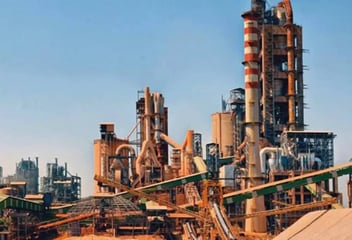The Solution - How to Control Emissions in the Cement Industry
The cement industry is among India’s most polluting industries. Image courtesy: businesstoday.in
The Indian cement industry is the second-largest producer of cement globally. In the financial year 2020, the Indian cement industry had a turnover of Rs 64,000 crore. Dominated by around 30 prominent players, the Indian cement industry comprises around 210 large cement producing plants and 365 small ones. The industry continues to enjoy robust market demand through the pandemic situation, as India continues to be the second-largest global consumer of cement.
On the other hand, the cement industry is one of the most significant contributors to air pollution1. The cement industry contributes to around 7% of global carbon emissions. Particulate matter (PM) emissions from cement plants are very high, and cement is understood to be the most polluting industry in the world.
How Polluting is The Cement Industry?
Did you know that a single cluster of large-scale cement plants in a North Indian state is responsible for 5% of the world’s anthropogenic CO2 emissions7?
The effects of the cement industry’s pollution on life can be very severe. Below are some of the findings on its impact on humans and human-made systems:
- Random tests conducted on workers in cement industries in Bengal and Tamilnadu have shown that 1/5th of the worker population is affected by diseases such as bronchitis, asthma, and obstructive respiratory disease among others2.
- A recent study in Sri Lanka, which has ecological and geographical proximity with India, found that over 14% of the people living close to cement factories are afflicted with respiratory disorders2.
- In an interesting study conducted in the US, the economic benefits of reduced PM emissions from the American cement industry were estimated to range between 0.76 and 3.97 million USD annually3. The implications of such a finding in India, which produces three times the amount of cement produced by the US, are evident.
Sustainability Challenges Faced by the Cement Industry
For a lot of cement companies in India, emissions continue to be high, despite having installed pollution control systems. We come across news articles from time to time, citing cement firms paying heavy fines to the tune of tens of lakhs, if not higher6; or sometimes, even shutting plants for violating pollution norms. Shutting down a plant even for a month can seriously impact a company's sales and overall efficiency.
The most common pollutants commonly emitted by cement plants are dust or particulate matter, NOx, SOx, carbon oxides, and methane, among others. Cement being the major contributor to air pollution, an approximate number of 4,90,000 annual deaths may be attributed to emissions from the cement industry. Further, emissions from cement factories pose a threat to the life of surrounding flora and fauna.
Fugitive Emissions
How is carbon dioxide produced in a cement plant? One of the major challenges faced by the cement industry is unaccounted or ‘fugitive’ emissions. Fugitive emissions refer to pollutants that are ‘fugitive’ or escape from a source without being accounted for. Regular emissions from known sources are accounted for and hence easier to track and control. Fugitive emissions, on the other hand, are difficult to track since their source is unknown. Hence, they contribute to ambient air pollution in an untraceable way. The problem of fugitive emissions occurs during every stage of the cement manufacturing process and poses a huge challenge.
Existing Pollution Control Methods in Cement Industries
Conventionally, cement industry pollution control equipment includes electrostatic precipitators, baghouses, pulse jet filters, and industrial scrubbers. However, these have a limited and clearly defined area of coverage, and therefore, cannot treat fugitive emissions very effectively. The above-mentioned methods are energy-consuming, require regular and expensive maintenance. They are not very effective in treating ambient air pollution either.
Pollution Control to Improve Occupational Health and Safety in Cement Manufacturing Plants
An ideal solution for pollution control in cement industries should be able i) tackle the problem efficiently, ii) address fugitive emissions, iii) be cost-effective and sustainable.
Devic Earth’s Pure Skies is a breakthrough technology that does exactly this. It addresses large areas, cleaning ambient air pollution including fugitive and regular emissions. Pure Skies reduces air pollution by removing pollutants such as PM2.5, PM10, NOx, SOx, and others from the air.
Pure Skies is based on pulsed Wi-Fi technology. This is a filter-less and intelligent system that spreads signals over an area and clears pollutants. The technology accelerates the natural clearance of air pollutants and their formation into dry deposition. It operates in the normal Wi-Fi signal range and is completely safe. Further, it does not interfere with the activities of a manufacturing plant in any way.
Case Study
Pure Skies was installed at one of India’s leading cement manufacturing plants to mitigate the problem of high, often unaccounted emissions. Despite having in place pollution control systems, the plant still faced high emission of pollutants, and associated risks such as opposition from neighbouring communities, and also the administrative roadblocks in terms of closing the plant and/or being charged heavy fines.
Within one month of installation, Pure Skies
- Reduced PM2.5 levels by 48%
- Reduced PM10 levels by 50%
The plant benefitted from the immense drop in pollution levels and enjoyed the security and enhanced performance enabled by Pure Skies.
Benefits of Pure Skies
- It covers large areas. One unit of Pure Skies can easily cover acres of a premise.
- It is affordable. Pure Skies is a subscription service and lets you avail of clean air at an affordable monthly rate, also providing the flexibility to cancel anytime.
- It has a high rate of efficacy. Pure Skies has a proven high efficacy rate and brings down air pollution by 33-90%.
- It is filter-less. Pure Skies avoids all the hassles and extra expenses that most other air cleaners demand. It is a silent, plug-and-play technology.
- It leads to improved productivity and profitability. Installing Pure Skies has restored a great deal of productivity by reducing sick leaves and increasing employee productivity. Customers who've installed Pure Skies have seen a 13% year-on-year reduction in their employees' sick leave.
- Monitor air quality in real-time. Pure Skies comes with a third-party air quality monitor. It lets you visualize your air quality baseline, and then clearly note the reduction in levels of pollutants.
The World’s First Clean Air Subscription

Pure Skies is available for subscription, like most of today’s smart and user-friendly services. With a one-time activation fee, enjoy clean air always, with the flexibility to opt out anytime. Avoid CAPEX investment; pay a monthly fee as you go.
Subscribe to Pure Skies and enjoy exclusive benefits!
Our subscription plan comes with great advantages like flexibility, low cost, and convenience.
With Pure Skies, boost your performance, improve plant hygiene and achieve your sustainability goals.
Get Pure Skies for your Cement Plant Today!
(This article is conceptualized and co-written by Shashank Aggarwal & Vidhya Sreenivasan)
Citations
- https://economictimes.indiatimes.com/news/international/world-news/cement-produces-more-pollution-than-all-the-trucks-in-the-world/articleshow/69919005.cms?from=mdr
- https://indianexpress.com/article/india/india-others/death-by-breath-why-building-dust-is-lethal-mix/
- https://www.witpress.com/elibrary/wit-transactions-on-ecology-and-the-environment/42/3892
- https://business.mapsofindia.com/cement/cement-industry-jobs.html
- https://link.springer.com/chapter/10.1007/978-3-030-44248-4_18
- https://www.thehindu.com/news/cities/Delhi/cpwd-fined-5-lakh-for-flouting-pollution-control-norms/article32704680.ece
- https://link.springer.com/article/10.1007/s10098-020-01998-6
- https://www.downtoearth.org.in/news/environment/cement-industry-misses-deadline-for-new-pollution-norms-57548

.svg)
.webp?width=1080&height=1080&name=Free%20Case%20Study%20Steel%20Plant%20(1).webp)





Post Comments